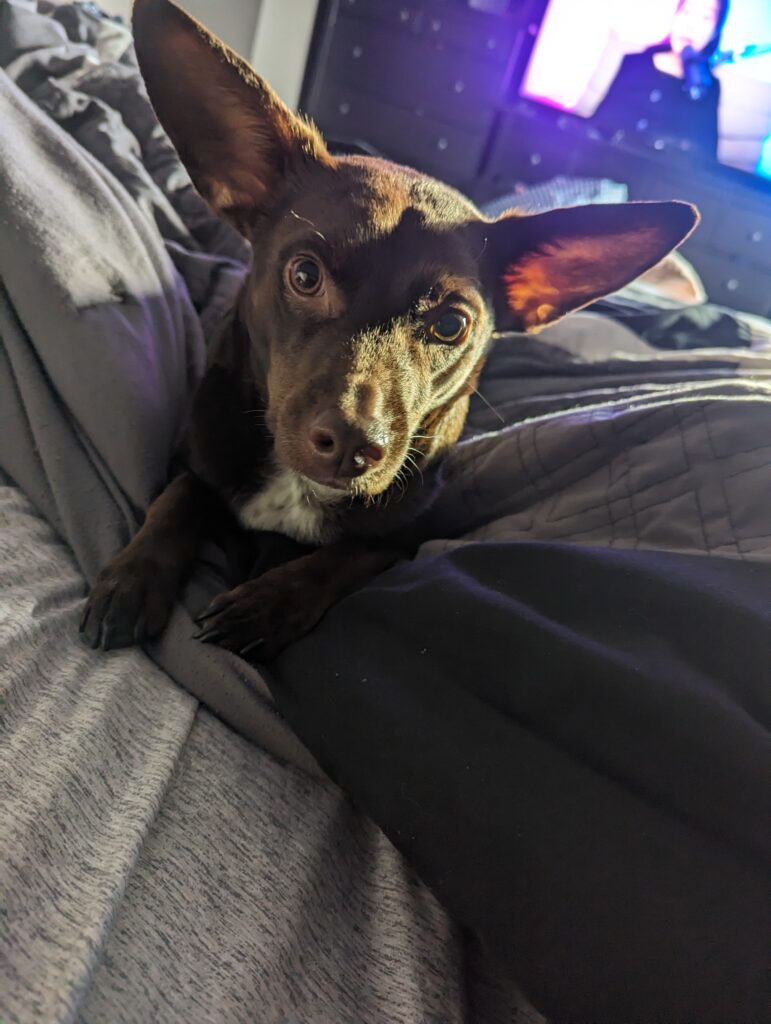It was a lovely, warm sunny day and I couldn’t wait to get my girl, Olivia, outside for a walk! She’s a big fan of being in the sunshine, and I thought it would be the perfect day for it.
For those unfamiliar with Olivia and her life, she is a very leash reactive, noise phobic pup living in Chicago. (And yes, we cannot wait to move somewhere quiet with a yard). We do not rely on leash walks as Olivia’s main form of “entertainment” as the stress of them often outweighs the benefits for her. We balance how she is feeling that day with her desire to go on walks and supplement with other activities as needed.
One of the factors in deciding whether a walk is a good bet is where Olivia is on her ladder of escalation.
At Pet Harmony, whether you are a client or a behavior professional, you’ve undoubtedly heard us bring up an animal’s ladder of escalation. Let’s dive a bit more into what that means. I’m going to use Olivia as a real-life example because I am intimately familiar with her personality, body language, and background.
This blog focuses specifically on Olivia’s ladders as they relate to leash walking as an example, but you can apply this to ANY situation where an animal is displaying an undesirable behavior.

What Is a Ladder of Escalation or De-escalation?
A ladder of escalation is a scale that indicates an animal’s level of arousal, from their baseline state (the calm, just chilllin’ and vibes part) up to, and sometimes over, their threshold (the point at which an animal goes into fight-or-flight mode). For more information on Thresholds, check out this article written by Mardi Richmond.
Knowing where a dog is on their ladder and if they’re on their way up the ladder of escalation toward fight or flight, or the way down the ladder of de-escalation toward rest helps us to make decisions about what actions we take next. For example, cueing a behavior, such as a flight cue, to move away and prevent escalation / promote de-escalation. Or we can use it to recognize that they are low enough on their ladder that they can make an appropriate choice without us needing to intervene.
We create this ladder using body language signals (Pet Harmony talking about body language? Say whaaaa?) that tells us how our dog is feeling. I created this worksheet after spending time noting and filming how Olivia looked throughout her walks, from mild triggers to larger ones. I also needed to be able to find what Olivia’s baseline outside really looked like.
Being aware of what these body language signals looked like for Olivia allowed me to create a shorthand for my ladder of escalation. Now when we go on walks, I’m able to sum up with a number what kind of walk we had! This also makes my data tracking much easier by being able to enter a number for our walks versus having to write out more detailed notes.
When we want to change behavior, one of the most effective things we can do is be pre-emptive. It’s important to have the ability to see your dog getting closer to an explosion, and apply whatever bomb-disabling technology you have IN ADVANCE of the behavior occurring. This prevents creating unwanted behavior chains. Think about when your dog jumps on you, then you ask them to sit and reinforce with pets and praise. This typically results in a dog learning that jumping, then sitting is the way to receive pets even though this wasn’t our intention!
Almost every single client Pet Harmony consultants work with are asked to create a ladder of escalation and/or de-escalation for their pet so they can learn to intervene before the undesired behavior has occurred. The issue that often presents itself is that we don’t realize how quickly where your pet is on their ladder can change!
Olivia’s Escalation: Recognizing the Early Signals
Here is the video I created demonstrating Olivia’s movement up and down her ladder in real time:
You can see from the video that Olivia’s position on her ladder changes frequently, as do my actions as a result. Though in the beginning she is capable of dealing with her triggers independently, as she continues to escalate, I interrupt and encourage movement to try to prevent her from going over her threshold.
If you had watched this video without the captions written in, would you have noticed all of the slight body language shifts? Would you have known where to interrupt? Truthfully, I didn’t even notice them all when I was editing the video. Other members of my team pointed out small things I hadn’t previously perceived. By being able to see Olivia’s earlier signs of stress, I was able to identify when I needed to help her out, and when I could let her problem solve on her own. If you need help recognizing your dog’s body language, your behavior consultant is more than happy to help!
While it’s near impossible to prevent your dog from ever going over their threshold (as seen in the video), there is lots of information we can use to make it happen less frequently!
Deescalation in Action: How Olivia Calmed Down
In the video, I also highlight what Olivia looks like as she is de-escalating. For her, this was a combination of skills she has already learned, and my participation in encouraging it. While Olivia chose to sniff to help de-escalate (yay, good girl!) I also added distance from the triggers, tried to utilize visual blockers, and encouraged the sniffing until I saw body language and calming signals that were closer to her baseline outside. I also work through my own stress by trying to speak calmly and keep my energy even. Us humans have ladders too!
What’s not shown in the video, but is still a vital part of your pet being able to de-escalate, is what you do after the exciting event has ended! Because the leash can make her so frustrated, I often will take Olivia onto our private, fully enclosed roof top right when we return so she can get out a few zoomies, then take time to sniff in a familiar, safe environment. If necessary, I can also give her a calming activity like a lick mat. If I see that she feels comfortable partaking in these activities, and the rest of her body language shows that she’s calm, I know we have de-escalated appropriately, which usually looks a like this:

Your furry, feathered, or scaled friend may have issues with both escalation and de-escalation, or just one. Olivia struggles with escalation, but can de-escalate on her own proficiently. Depending on what you are struggling with, you may want to spend time working on one, or both!
How to Create Your Own Pet’s Ladders of Escalation and De-escalation
Observe your dog’s baseline. The lovely Ellen Yoakum has an excellent blog on finding your pup’s baseline here. Hint: Their baseline may change depending on the environment! Olivia’s baseline outside is already slightly aroused, whereas inside she acts like a different pup.
Look for changes in their body like tensing or stiffening, weight shifting forward or back, vocalizations like whining, barking, growling, or as I describe most Frenchie noises, gurgling. Watch to see if their movement becomes faster or slower, rhythmic or erratic. And remember that context matters! A shake off when your dog is wet means something entirely different than a shake off from a dry dog.
If it is safe for you to do so, I encourage you or someone with you to film your dog when trying to assess their body language in a certain situation. It can help to be able to review video when you’re not on edge because your dog is ramping up
Now What?
We are always learning.
If you are dealing with a dog who has trouble working through their ladders of escalation and de-escalation, you are far from alone! This is an issue I see in most of the pups I work with. Rewatch the above video and see if you can identify any of the body language signals Olivia displays in your own dog! It takes time and practice. If you need help, know that our consultants are here for you! Remember, to continue to meet all of our pet’s needs, we have to be able to identify what needs they’re missing first!
Here’s to harmony,
Claire


